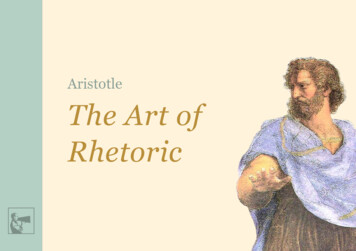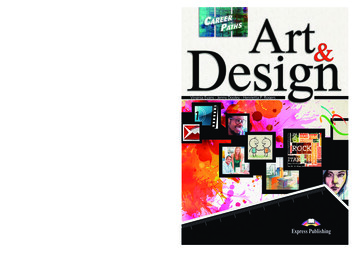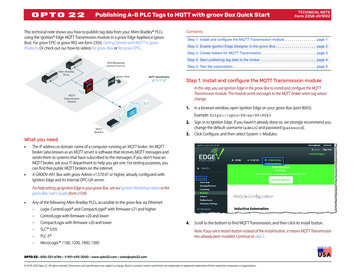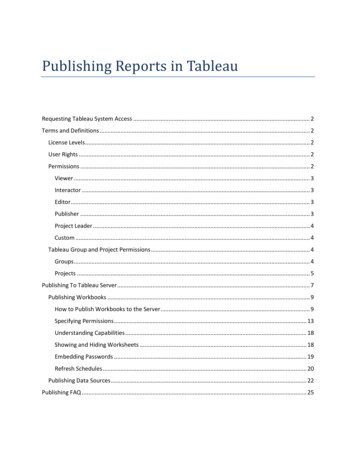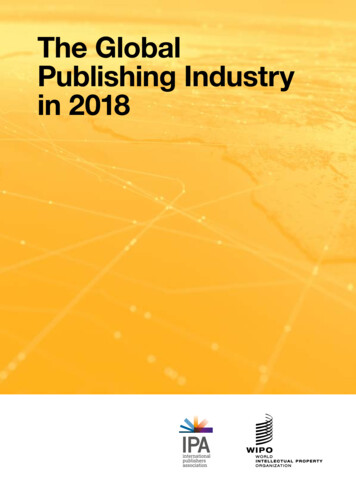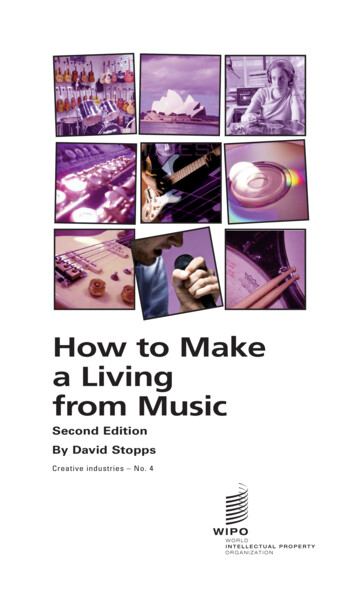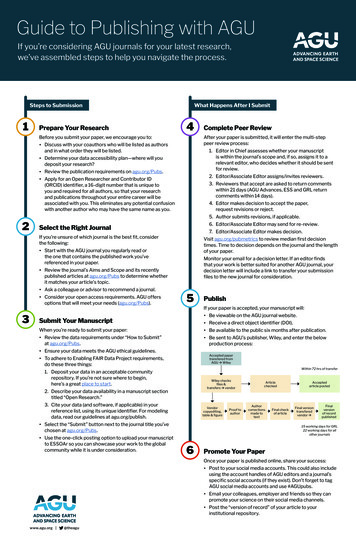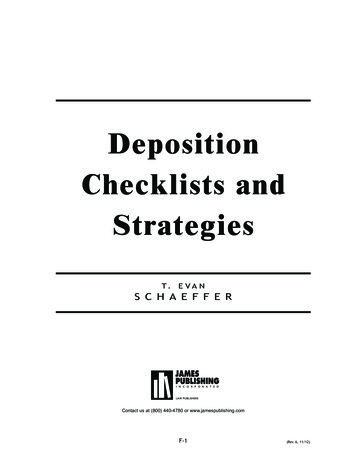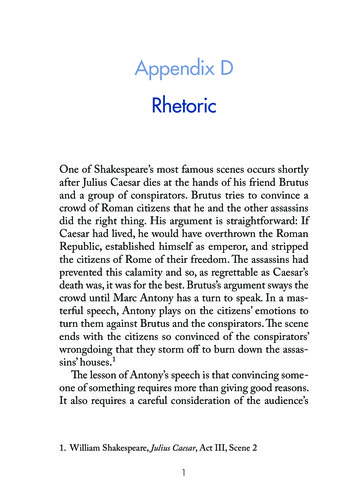
Transcription
Appendix DRhetoricOne of Shakespeare’s most famous scenes occurs shortlyafter Julius Caesar dies at the hands of his friend Brutusand a group of conspirators. Brutus tries to convince acrowd of Roman citizens that he and the other assassinsdid the right thing. His argument is straightforward: IfCaesar had lived, he would have overthrown the RomanRepublic, established himself as emperor, and strippedthe citizens of Rome of their freedom. The assassins hadprevented this calamity and so, as regrettable as Caesar’sdeath was, it was for the best. Brutus’s argument sways thecrowd until Marc Antony has a turn to speak. In a masterful speech, Antony plays on the citizens’ emotions toturn them against Brutus and the conspirators. The sceneends with the citizens so convinced of the conspirators’wrongdoing that they storm off to burn down the assassins’ houses.1The lesson of Antony’s speech is that convincing someone of something requires more than giving good reasons.It also requires a careful consideration of the audience’s1. William Shakespeare, Julius Caesar, Act III, Scene 21
2Appendix Demotions and their perceptions of the speaker.2 Most ofthis book focuses on the art of reasoning, but that is onlyone part of the broader study of rhetoric, which we mightloosely define as the art of persuasion. Like the study ofreasoning, the study of rhetoric dates back to ancientGreece, where the philosopher Aristotle identified threemain methods of persuasion, corresponding to each of thethree things mentioned above—the speaker, the audience,and the argument. These methods still go by the Greeknames that Aristotle gave them: ethos, pathos, and logoswhich mean something like character, emotion, and argument, respectively.The Greek word ethos refers to the speaker’s moralcharacter. The idea is that a speech will be more persuasiveif the audience perceives the speaker as a decent, trustworthy, credible person. To persuade someone by an appealto ethos, then, involves the speaker saying things that willmake the audience regard him or her as someone theycan trust on the topic at hand. This is especially importantin cases where, because of the topic being discussed, theaudience will be forced to rely on the speakers’ judgmentor expertise.Speakers can establish credibility with the audience invarious ways. Sometimes speakers seek to establish theirown expertise or authority on the topic. For example,during his 2016 presidential campaign, Donald Trumppromised that he would renegotiate trade deals and build2. Although I will refer to “the speaker” and “speeches” throughoutthis appendix, everything I say here applies just as much to persuasivewriting as to speeches.
Rhetoric3a wall on the Mexican border. In his speeches, he frequently appealed to his expertise as a savvy dealmakerand a successful builder to persuade his audience that hecould deliver on those promises. Sometimes speakers tryto establish their credibility by presenting themselves asgood, likeable, or relatable, since this can make the audience regard a speaker as more trustworthy in general.When it comes to persuading an audience that anotherspeaker is wrong, undermining that speaker’s ethos is ofteneffective. This is Cassius’s approach in Julius Caesar, inwhich he undermines the crowd’s trust in Brutus by raising doubts about Brutus’s honor and honesty. In manycases, however, this approach amounts to an ad hominemfallacy, since the other speaker’s argument should usuallybe able to stand on its own.3 There are exceptions. Sometimes the audience is relying on the speaker’s authority todecide whether to believe crucial premises in his or herargument. In that case, showing that the other speakeris untrustworthy helps prevent the audience from beingdeceived.Whereas ethos concerns the speaker, the next methodof persuasion, pathos, concerns the audience. The Greekword pathos refers to emotion. The idea is that people donot respond to arguments in the same way when they arehappy as when they are sad; they do not respond the sameway when they are fearful as when they are confident.For instance, a jury that feels sorry for a defendant mightlisten more sympathetically to arguments for the defendant’s innocence, a crowd that feels frightened might be3. On the ad hominem fallacy, see pp. 60, 62, and 78 in Giving Reasons.
4Appendix Dmore inclined to accept an argument for stricter securitymeasures, and so on. Thus, a speech will often be morepersuasive if the speaker can get the audience into theright emotional state to make them receptive to his or herargument. Note that this is not necessarily for the purposeof motivating the audience to do something, since manyspeeches aim not to get the audience to do something butonly to get them to believe something.To see how speakers use pathos to shift the beliefs oftheir listeners, consider a recent speech in which the journalist Stephanie Busari tries to convince her audience that“fake news” is dangerous. Busari provides only one example of fake news allegedly doing harm: the story of the“Chibok girls,” a group of over two hundred teenage girlswho were kidnapped from a school in Chibok, Nigeria in2014. When Busari interviewed Nigerian officials shortlyafter the incident, many insisted that it was a hoax—thatthe girls had never really been kidnapped. Other onlinehoaxes had made the officials suspicious, Busari implies,and this significantly delayed the officials’ response tothe kidnapping. As arguments go, this isn’t a particularlystrong one: it rests on a single example, and Busari doesn’tgive much reason to think that the Nigerian officials’familiarity with online hoaxes changed their behavior. Butthe example she chose is an emotionally powerful one, andshe illustrates it with two especially moving vignettes. Shetells of a girl who escaped from the kidnapping by leaping from a moving truck. She broke both her legs in thefall and pulled herself into the bushes to hide from thekidnappers, terrified that they would return. Busari also
Rhetoric5speaks about—and shows pictures of—some of the girls’sobbing parents, who say that they chased the kidnappers’trucks as they drove off with their daughters, only to bedeterred by gunfire.4 Having moved her audience to feelthe girl’s fear and the parents’ rage, horror, and helplessness, Busari scarcely has to offer any reasons to convinceher audience of the dangers of fake news. This is the powerof pathos: a speech that elicits enough feeling can sometimes convince its audience even without much of a logos.The Greek word logos refers to an argument. The logosof a speech consists of the reasons that it gives to try toconvince the audience of something. We have reviewedthe elements of a good argument in Chapters 2, 3, and4: a good argument requires reliable, relevant premisesthat are strong enough to support its conclusion. Nothingabout that changes when we step back to look at persuasion from the broader perspective of rhetoric. Instead, wesimply see that constructing a good argument is often onlyone part of persuading people of something.To see how these three elements can fit together, considera famous speech by Noah “Soggy” Sweat, Jr., a lawyer, legislator, and judge from Mississippi. Sweat was elected tothe Mississippi House of Representatives in 1947 at theage of 24. Although the U.S. government had repealedProhibition in 1933, the state of Mississippi continuedto prohibit hard liquor. Toward the end of his only term4. Stephanie Busari, “How Fake News Does RealHarm,” TED, February 2017, https://www.ted.com/talks/stephanie busari how fake news does real harm
6Appendix Din the House of Representatives, Sweat took the floor todeliver a speech about legalizing liquor sales in Mississippi. He began as follows:My friends, I had not intended to discuss this controversialsubject at this particular time. However, I want you to knowthat I do not shun controversy. On the contrary, I will take astand on any issue at any time, regardless of how fraught withcontroversy it might be. You have asked me how I feel aboutwhiskey. All right, here is how I feel about whiskey.If when you say whiskey you mean the devil’s brew, the poisonscourge, the bloody monster, that defiles innocence, dethronesreason, destroys the home, creates misery and poverty, yea,literally takes the bread from the mouths of little children; ifyou mean the evil drink that topples the Christian man andwoman from the pinnacle of righteous, gracious living intothe bottomless pit of degradation, and despair, and shame andhelplessness, and hopelessness, then certainly I am against it.5The basic logos of this part of Sweat’s speech is simple:(1) Whiskey has very bad effects.Therefore, (2) Whiskey should remain illegal.5. Quoted in Jebb Johnston, “Court Pays Tribute to ‘Soggy’Sweat,” Daily Corinthian (Corinth, MS), October 20, 2016,http://www.dailycorinthian.com/view/full stor weat
Rhetoric7We could elaborate on this argument by listing thespecific bad effects that Sweat mentions, but these arenot what makes Sweat’s speech so powerful. What setsSweat’s speech apart is his use of ethos and pathos. Hebegins his speech with an appeal to ethos, trying to establish himself as an honest, principled man who “will take astand on any issue at any time, regardless of how fraughtwith controversy it might be.” He also implies that he isnot some partisan politician eager to win points for hisside; rather, he is only expressing his views about whiskeybecause the legislature has asked him to do so.The second paragraph sparkles with colorful language designed to dramatize whiskey’s dangers. It is “thedevil’s brew, the poison scourge, the bloody monster.”It “dethrones reason, destroys the home, creates miseryand poverty,” he says, and even “takes the bread from themouths of little children.” This is no sober account of thebad consequences of legalizing whiskey; nor is it a dry listof statistics about the ills created by hard liquor. Rather,the words and images are carefully chosen to stoke fear,anger, and resentment toward whiskey and those whoindulge in it, as well as pity for the innocents who sufferas a result. This appeal to pathos makes the speech muchmore powerful as a tool of persuasion.By Sweat’s own account, the supporters of Prohibitionin the legislature burst into applause when he reached thispoint in his speech. But Sweat wasn’t done. He continuedin the same style, with a twist:
8Appendix DBut, if when you say whiskey you mean the oil of conversation, the philosophic wine, the ale that is consumed whengood fellows get together, that puts a song in their heartsand laughter on their lips, and the warm glow of contentment in their eyes; if you mean Christmas cheer; if you meanthe stimulating drink that puts the spring in the old gentleman’s step on a frosty, crispy morning; if you mean the drinkwhich enables a man to magnify his joy, and his happiness,and to forget, if only for a little while, life’s great tragedies,and heartaches, and sorrows; if you mean that drink, the saleof which pours into our treasuries untold millions of dollars,which are used to provide tender care for our little crippledchildren, our blind, our deaf, our dumb, our pitiful aged andinfirm; to build highways and hospitals and schools, thencertainly I am for it.This is my stand. I will not retreat from it. I will notcompromise.6Now it was the opponents of Prohibition who burstinto applause. Set aside, for the moment, the strange factthat Sweat seems to contradict his earlier position, andconsider this second half as if it were a separate speech.The basic logos of the second half of the speech is clear:(1) Whiskey has good effects.Therefore, (2) Whiskey should be legalized.6. Quoted in Johnston, “Court Pays Tribute to ‘Soggy’ Sweat”
Rhetoric9As with the first half, the strength of this half of Sweat’sspeech lies not in its logos, but in its appeal to ethos andespecially pathos. The closing lines—“This is my stand. Iwill not retreat from it. I will not compromise.”—onceagain evoke an ethos of courage, integrity, and principle.And in direct opposition to the first half of the speech,Sweat chooses words and images that evoke happy emotions. He calls it “the oil of conversation, the philosophicwine” that “puts a song” in people’s hearts and on theirlips and brings “Christmas cheer.” He also tries to arousehis listeners’ sympathy by emphasizing that the taxes onliquor could fund “tender care for our little crippled children, our blind, our deaf, our dumb, our pitiful aged andinfirm.”Taken as a whole, however, the point of Sweat’s speechremains obscure. While each half of the speech offers adazzling lesson in rhetoric, it is unclear what to make ofthe two halves together. Perhaps Sweat intended to showthat legalizing hard liquor would have both good and badeffects, and that the choice between them was difficult.Perhaps he wanted to score political points with peopleon both sides of the issue without having to truly take aside himself. Perhaps he was simply playing a prank on hisfellow legislators. Whatever the case, Mississippi declinedto legalize liquor that year. One wonders whether thatmade Sweat happy.As these examples show, rhetoric is a powerful tool—evenmore powerful than reasoning alone. It can be used to
10Appendix Dsupport a good argument or make up for a weak one.Therefore, it can be used for good or for ill, to informor to mislead. This is precisely why understanding rhetoric—including ethos and pathos—is important for criticalthinking: it helps you recognize when someone is usingrhetoric to deceive you and it helps you convince otherswhen reason alone is not enough.This appendix is a supplement to Giving Reasons,by David R. Morrow ( Hackett 2017).
a famous speech by Noah “Soggy” Sweat, Jr., a lawyer, leg - islator, and judge from Mississippi. Sweat was elected to the Mississippi House of Representatives in 1947 at the age of 24. Although the U.S. government had repealed Prohibition in 1933, the state of Mississippi continued to prohibit hard liquor. Toward the end of his only term 4. Stephanie Busari, “How Fake News Does Real Harm .
